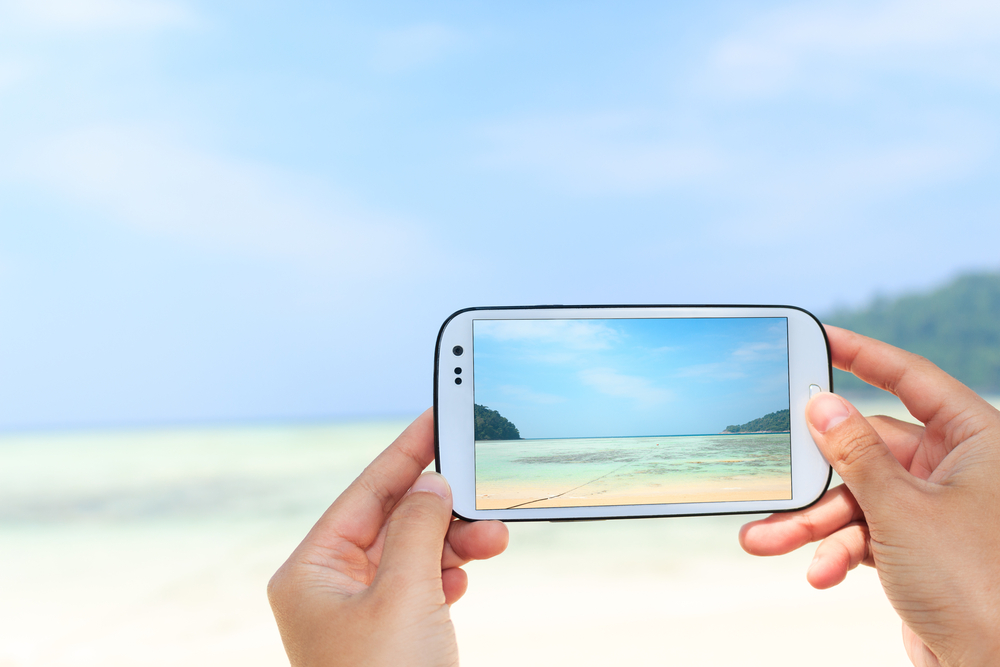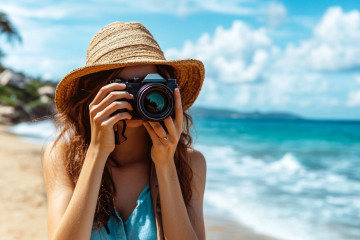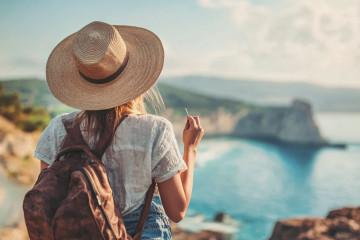Want to take better beach photos? Well, we’ve got 12 tips to help you do just that so next time you’re at the coast, your beach photos will stand out from the crowd.
1. What Gear Do I Need?
- Camera – Compact or DSLR
- Camera bag – Keep your gear safe from sand and sea salt when you’re not using it.
- Tripod – Something lightweight and portable will be perfect as it won’t take up too much room in the car and your arms won’t ache after carrying it around all day.
- Polarising filter – Help reduce reflections and boost contrast.
- UV filter – Protect your lens from scratches.
- Hurricane blower and lens cloth – Make sure your lens is free of sea spray and keep grains of sand out.
2. How To Protect Your Gear
You might enjoy a day out at the beach but your photography gear won’t. Make sure you wipe all of your gear down when you get home and leave it to dry out completely. Spiked feet will stop your tripod slipping into the sand as you’re trying to frame up while a UV filter will help stop sand scratching your lens. When you’re not using your camera, remember to put it back in your bag and if you’re using a DSLR and want to change lenses, try and do it off the beach and out of the wind so sand doesn’t get blown where it shouldn’t be.
3. What About Time Of Day?
The warm light of an evening will give you better results than midday sun or if you’re a morning person, get up early when the sun’s at a lower angle so your shots will be more evenly lit without large, deep shadows running through them. There will be less people around at this time too as most of the day-trippers will have left if it’s later in the evening or not arrived if you’re up at the crack of dawn. Don’t dismiss shooting a few shots of a busy beach though, particularly if it’s a hot weekend and the sand can’t be seen for towels and seats.
4. Don’t Just Look Out To Sea
Sweeping vistas of the ocean and cliffs do look great but do try turning around with your camera and photograph the scene that’s unfolding behind you. Just be careful who you point your lens at as there is a chance it will upset some parents who’ll want to know why you’re photographing their children. Try capturing shots that help tell the story of what happened at the beach – close-ups of sun cream bottles, buckets, spades and dropped ice cream cones make great ‘fill-in’ shots for photo albums and photo books.
5. Look For A Focal Point
When you do shoot out to sea try giving the shot a focal point in the foreground otherwise it can look a little empty. Driftwood, rocks and footprints are just three things you could use to add an extra element of interest to your shot. Just check you’re using a small aperture before you take your shot to ensure front-to-back sharpness.
6. Focus On The Water
To turn the waves into a smooth, dry ice-like motion you need to set your camera on a tripod and dial down to a slow shutter speed. How slow you need to go will depend on the movement of the waves and how bright it is so some experimentation will probably be needed. If you’re struggling to get the speeds you need use a polarising or ND filter to reduce the amount of light entering the lens.
7. Change Your View
If there’s a pier get on top of it to give yourself some height. You’ll then be able to get more of the beach scene in shot. If you’re using a compact camera that has a tilt-shift mode, getting up on the pier will give you the chance to turn the people sat on the beach into model-like characters. If there isn’t a pier try extending the centre column on your tripod to give you more height. You may want to pack a remote release in case you can’t reach the camera’s shutter button when your tripod’s extended. It’ll also help reduce the chances of shake spoiling your shot.
8. Check Your Horizons
You need to make sure your horizon’s straight and try moving its position to draw the viewer’s attention to a particular part of the shot.
9. Shoot A Sunset / Sunrise
You can’t go to the coast without photographing a sunrise/sunset (depending on which coast you’re on). Just remember to have yourself at your chosen location an hour or so before sunset/rise and make sure you pack your tripod as working hand-held in these low light situations will only cause shake.
10. Capture Some Close-Ups
Shells and pebbles are just two subjects you can use for a spot of close up photography on the beach.
11. How To Deal With Exposure Problems
The problem with sand sat against a light sky is that it can confuse your camera into underexposing the shot so try using exposure compensation to deliberately overexpose the scene. It can be tricky getting the whole scene exposed correctly and bracketing can help, however, if you have subjects that can’t stay still, your shots won’t line up when you’re back in front of your computer.
If you’re working with a compact camera switch it to Beach scene mode from the camera’s scene mode or picture mode menu. The Beach scene mode will increase the exposure slightly to compensate but also adjusts the white balance to make the sand look more natural.
12. Photograph People
To capture your kids running around switch to fast shutter speeds and continuous shooting mode. If you want to slow things down try getting them to do something that’ll keep them in one place such as building a sandcastle you’ll be able to get some great frame-filling shots of their faces to show their expressions but do zoom out a little too as this will give the shot context. If you find the sun’s casting shadows on their face try adding a little fill-in flash and avoid positioning the sun behind you as this will only make them squint.



